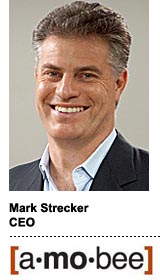 Why did Singapore Telecommunications’ ad tech subsidiary Amobee buy Adconion and Kontera for a combined $385 million?
Why did Singapore Telecommunications’ ad tech subsidiary Amobee buy Adconion and Kontera for a combined $385 million?
For Amobee CEO Mark Strecker, it was a matter of moving Amobee’s focus from mobile advertising to digital advertising. And the company needed Kontera’s technological assets and Adconion’s business organization to accomplish that. Once integrated, Amobee will have a combined headcount of more than 600 people in 21 offices around the world.
“We’re looking forward to the next stage of the company,” he told AdExchanger.
AdExchanger: Since you brought it up, what is the next stage of Amobee?
MARK STRECKER: The plan is to integrate both Adconion and Kontera. We want to grow the business to become an independent digital advertising company. I’ve been talking to a lot of chief marketing officers and various advertisers and their agencies. They’re looking for someone completely independent for their ad spend, rather than to connect all their marketing dollars to the Google and the Facebooks of the world.
We want to give them a one-stop shop for their ad units. Obviously Amobee’s core strength is in mobile advertising, which is really growing in Asia. But now we can bring social and email and video as a part of that. We have a very unique technology with the Kontera deal, and the idea is to integrate all of that in the next six months. We’ll have one brand and we’ll go to market.
Six months isn’t that long off.
Kontera is a pure tech play, to be honest. They have some business around native, social advertising. But it’s really a nice tuck-in for us in our engineering group. So there’s not a lot of integration to be honest.
On the Adconion side, they have some of the technology, which we’ll pull into a few deals, but they’re primarily a big business organization. Kim [Perell], the CEO there, will report in to me. So it’s going to be relatively straightforward. Now, the devil’s in the details, as they say, but we’re optimistic we’ll get this done in six months.
Have you worked with Adconion and Kontera before?
We’d done more work with Adconion than with Kontera. We’re executing a lot of the mobile side of Adconion’s business. That’s how we got to know them. They were using us for their programmatic buying. They were more of a customer than anything else, using our technology and mobile platform.
Why did you acquire them now?
In terms of Amobee and our strategy, we were acquired ourselves two years ago. We wanted to create a global advertising business. In our case, we had the mobile side of things. But back in 2012, there was a sizeable market just to support mobile advertising. You could go into the brand and help execute their mobile campaigns, or on the publishers’ side, you could manage all the publisher inventory. But now as more stuff has consolidated, people are just thinking in terms of digital, so now you’re doing social, email and all that stuff is on a mobile phone.
It’s a multidevice world. People have several devices. So people are saying they don’t just have a mobile advertising budget, they’ve got a digital advertising budget, of which mobile is a central component. But there are all these other digital screens. If you go into it with a pure mobile value proposition, at the core there’s a lot more to it. For us to be a leader in the digital advertising space, we’re going to need more than just mobile.
What do Adconion and Kontera give you that you didn’t have before?
Adconion gives us more scale in North American and Australia. We’ve already got a good business presence in Europe and a very strong business in Asia. But Australia is a very big part of the advertising market, outside of Japan and China. Adconion gives us the scale and the ad units.
What about Kontera?
The industry is moving to programmatic buying. It’s still relatively small in the scheme of things, but it’s better than where it was in the mobile world. Kontera can give us more insights in real time at how campaigns actually work, particularly in the social sphere. Whether that be Twitter or Facebook. If stuff is trending, we can measure that in real time.
Kontera basically tells you what’s going on right now and gives you a look into the future. It’s going to help us in the short term, and it gives us a native advertising ad unit. The way Kontera makes money today is, if you read an article or a piece of text, you’ll pick up brand names and you can mouse over a word. It’ll then serve an ad within the context of the actual article.
Using the Kontera technology will allow us to have a lot more data than we do. What we have today is more historic data. Kontera allows you to analyze data in real time based on what you’re doing there and then, and gives you insights into the future so you can show a much more relevant ad. Advertisers will pay a lot more for that.
We’re going to build around Kontera. The two acquisitions for us are a step up in terms of what Amobee can provide. Down the road, we’re going to come up with some very unique products.
What would be your ideal client? Are they small companies, big companies with relationships with marketing clouds?
We tend to deal with the big guys. It’s the big, big brands. Even today, many Fortune 500s don’t have mobile websites. They do some digital advertising, but they’re spending on TV and print. They might have some in-house teams or maybe they’re working with one of the bigger agencies. But the key for us is bigger brands with global scale. They’re spending north of $100 million in advertising and digital advertising. The Unilevers and Procter & Gambles of the world. We need to come in and help execute digital campaigns globally. We’re working across 50, 60, 70 different countries.
How many clients do you have? What do you anticipate once you complete your integrations?
Today, we are deployed in the high tens of customers. We’re the opposite of Google. We’re not self-service. We go in with dedicated teams, with white-glove service, and provide a lot of value with the brand directly or with their agencies. Sometimes brands have their own in-house teams and they’ll just outsource and work through us for their digital advertising and marketing. If the client has a relationship with the WPPs or Omnicoms of the world, we’ll work with those agencies.
Today, it’s tens. Adconion has hundreds of clients, and the nice thing is when we look at the deal, there’s only 10% overlap of our customer base. There’s a lot of opportunity for us to sell Amobee product into Adconion customers and vice versa.
Kontera has primary focus is in the US and has a few tens of customers. But the big play here was the Kontera technology.
Is Amobee a tech vendor, a marketing services provider, or an agency?
We are a digital advertising technology company. We’re providing software and solutions to marketing organizations. Think of us like an Oracle or a Salesforce for the marketing organizations. We’re definitely not a pure-play advertising agency, though we have those types of services.
Advertisers will give us money and we’ll spend it where we believe is the best place to try what they want. But we’re a bit like how DoubleClick was before they got acquired by Google. We have an ad server using the data – that’s what we use the telco data for. And we serve ads to drive revenue for the enterprises and help monetize their Wi-Fi inventory, for example. So for Cisco, we’re their exclusive ad serving advertising partner for all their clients. The Telefonicas, the Vodafones, the SingTels of the world, all the telcos use us to help drive revenue in mobile and our more traditional inventory.
Of course, Oracle and Salesforce would say they’re the Oracle and Salesforce for the marketing organization. Are you competitors?
I would say yes. But we’re very different. When we walk into the room, Oracle cannot talk the marketing language. When I walk into the CMO suite and I talk marketing, I walk in like an advertising agency. Oracle is selling servers and talking APIs. The CMO just doesn’t understand the language. At the end of the day, they’re trying to sell software. When we go in there, we say we understand their brands. Our presentations are like an advertising agency. This is how the campaign is going to run, and underneath it is all this technology. We completely flip the way we go to market. It’s affecting the same customer, but when we do it versus when Oracle does it, it’s a completely different experiment.
So this is where that white-glove service you mentioned comes into play.
Exactly. You’ve got the big guys, and today they don’t get along. Let’s say your brand wants to get into digital. I’ll spend $100,000 and buy Google keywords or Facebook, but there are so many other sources of inventory out there. And that’s where we come in. Our clients spend north of $1 million a month. They want someone who’s an expert. It’s a big business number. There’s so much more quality inventory than Google and AdWords. Depending on what you want to do, some inventory is way better than others.
You mentioned some clients want to avoid dealing with Google. Why is that?
They feel Google will just sell them Google products. If you’re an advertiser you want to get the best return on your marketing dollars. Google may not be the right source of inventory based on what you’re doing. Google is very weak in Asia for example, especially in China. As you get into more emerging markets, you’re not just going to by search words. We’ll still buy inventory on Google, but we’ll spend the budget across all other types of inventory.














